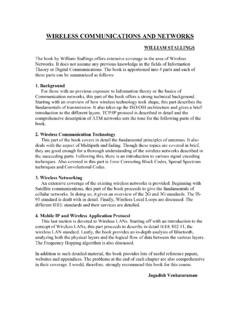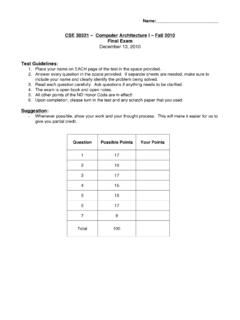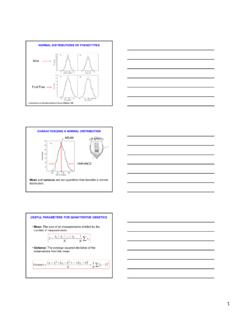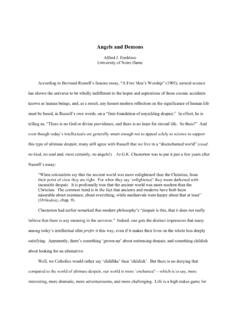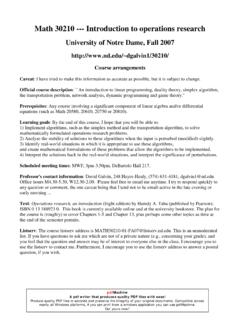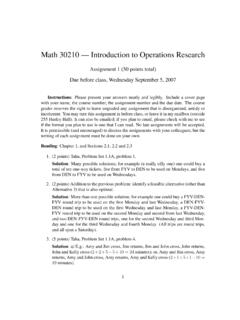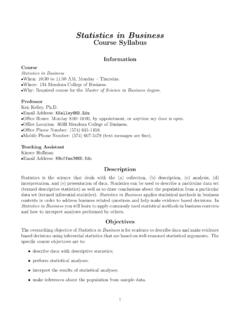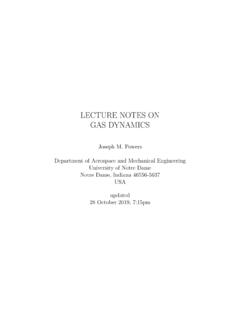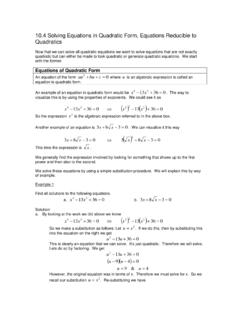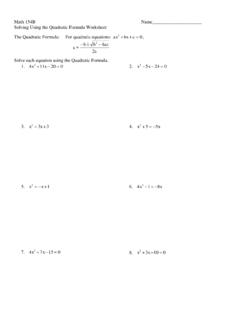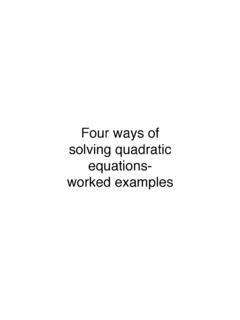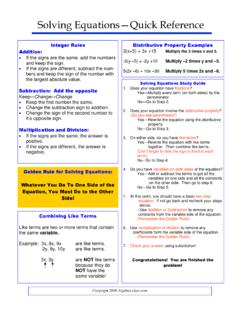Transcription of Lecture 5 : Solving Equations, Completing the Square ...
1 Lecture 5 : Solving equations , Completing the Square , quadratic FormulaAn equation is a mathematical statement that two mathematical expressions are equal. For examplethe statement1 + 2 = 3is read as one plus two equals three and means that the quantity on the left hand side is equal to thequantity on the right hand side When we have an equation of the form4x+ 1 = 3wherexis a variable, there are a limited number of possibilities for the value ofx, in fact in this case,there is just one possible value forx. Asolutionto this equation is a value ofxthat fits the equationor a value ofxwhich makes the statement for is important for students to write mathematical statements in such completesentences and students who do not develop such habits often have difficulty in Solving complex problemslater, simply because they cannot keep track of their own equationin one variable is an equation equivalent to one of the formax+b= 0whereaandbare real numbers andxis the we wish to solve for the feasible values ofxin such an equation, we bring all terms involvingxto one side of the equals sign and all other terms to the other side, and divide by the coefficient ofxtosolve forxin the following linear equations :4x+ 1 = 33x+ 2 =x+ 1 ExampleIn related rates problems in Calculus I one frequently has to express a variable in terms ofanother variable.
2 Here is an example:Express the surface area of the box below in terms of its width (w), length (l) and height (h). Thensolve for the width in terms of the other EquationsAQuadratic Equationis an equation of the form (or equivalent to)ax2+bx+c= 0wherea, bandcare real numbers anda6= (real) solutions of a quadratic equation are the real numbersxwhich satisfy the equation or makethe statement true. There are three possible scenarios1. There is exactly one real There are two distinct (not the same) real There are no real solutions (in this case there are two solutions in the complex numbers).There are a number of ways to approach finding the solutions to such an equation, all of which will beuseful in an equation by FactoringThe following basic property of real numbers is important forsolving all equations and will be used frequently throughout calculus and higher mathematics courses:Zero-Product PropertyAB= 0if and only ifA= 0 orB= term if and only if is a frequently used logical statement and it means that if the statementon the left hand side is true then the statement on the right hand side is guaranteed to be true alsoand vice-versa (if the statement on the right is true, then the statement on the left is guaranteed to betrue.)
3 We can use this and our factorization techniques to solve (some) quadratic the equationx2+ 10x= Simple quadratic EquationsThe solutions to the equationx2=c,wherec >0arex= candx= a quadratic of the formx2=cwherec <0, there are no solutions among the real numbers,because the Square of any real number must be the solutions to the following quadratic equationsx2= 9,(x 2)2= 16 Completing The SquareThis technique helps us to solve quadratic equations but is also very usefulin its own right especially in graphing functions. It is important to master it before studying calculus. To makex2+bxinto a perfect Square , we must add(b2)2to it ( we add the Square of half ofthe coefficient ofx). We getx2+bx+(b2)2=(x+b2)2. To convert a quadratic equationx2+bx+c= 0 into the form (x+d)2+e= 0, we add(b2)2toboth sides of the equation and then bring all terms to the left. We getx2+bx+(b2)2+c=(b2)2or(x+b2)2+[c (b2)2]= 0 ExampleSolve the following quadratic equations by Completing the Square :x2 6x+ 12 = 02x2 8x 20 = 03 The quadratic FormulaThe above technique of Completing the Square allows us to derive a generalformula for the solutions of a quadratic called the quadratic formula.
4 Below we give both the formulaand the quadratic FormulaThe roots (solutions) of the quadratic equationax2+bx+c= 0 wherea6= 0arex= b b2 we divide each side of the equation byato getx2+bax+ca= 0We then complete the Square forx2+baxby adding(b2a)2to both sides:x2+bax+(b2a)2+ca=(b2a) follows that(x+b2a)2+ca=(b2a) subtractingcafrom both sides, we get(x+b2a)2=(b2a)2 the fractions on the right, we get(x+b2a)2=b24a2 ca=b2 we have a simple quadratic equation(x+b2a)2=b2 4ac4a2with solutionsx+b2a= b2 our solutions arex= b b2 4ac2a. Tip For SuccessIf you intend to be a math major, it is a good idea to start reading proofs andfollowing the logic involved. This is in fact a good idea for all the quadratic formula to find the solutions of the following quadratic + 3x 1 = 02x2+ 10x+ 10 = 0x2+ 5x 4 = DicriminantNote that there are no real solutions to the quadratic above whenb2 4ac <0because we cannot take the Square root of a negative number.
5 Below we explore all possible a general quadratic equationax2+bx+c= 0, wherea6= 0, is given byD=b2 have the following possibilities:1. IfD >0, then the equation has two distinct real IfD= 0, the equation has exactly one real IfD <0, the equation has no real solutions (it has complex solutions in this case).ExampleUse the discriminant to determine how many real solutions each equation has:x2+ 2x+ 1 = 0x2 3x 3 = 02x2 10x+ 20 = 0 Path of a projectileA commonly used example in Calculus I and II is that of the path of an objectthrown or fired straight upwards from an initial heighth0with an initial speed ofv0feet per second(ft/s). Lettingh(t) denote the height of the object aftertseconds, you will see in Calculus I that if theEarth s gravity is the only force acting on the object thenh(t) = 16t2+v0t+ this is degree two polynomial in the variablet, we can use our knowledge of quadratic equationsto retrieve information about the path of the ball is thrown vertically upwards from a height of 32 feet with an initial velocity of 80 feetper When does the ball fall back to ground level?
6 2. When does the ball reach a height of 20 feet?5 Other Types of EquationsWe may have to solve equations involving fractional algebraic expressions. There are two rules that weshould keep in mind when Solving such expressions:Rule 1, Rational Expressions: IfAB= 0, then we must haveA= 0. Technical issue This is not an if and only if statement, the equationA= 0 may have more solutions than the original equation,since some of these solutions may satisfyB= 0 and thus may not be in the domain of this fractionalexpression. This technical issue becomes important when finding the roots of a rational function. Sowhen we use this rule to find the roots of a rational function later, we should look over the solutionsand discard any that do not belong to the domain of the original rational forxin the following equationsx2+ 2x+ 1x2 x 2= 0,1x 1+xx+ 1= 0,(x+ 1)(x 3)(x+ 2)x2 9= 2: equations involving radicals: If A=B, then (squaring both sides) we must haveA= this is not an if and only if statement, since we may have a solution toA=B2, which doesnot satisfy A=B( A = 1, B = -1).
7 So when we use this rule to solve an equation, we shouldlook over the solutions and discard any that do not satisfy the original the following equations x 1 =x 7, (x 1)2+ (2x 4)2= 5 equations involving absolute valuesWhen dealing with absolute values, we must always keep inmind the definition of the absolute value:|a|={aifa 0 aifa 06To solve an equation of the form|A|=Bwe must consider the solutions to two equationsA=Band A=B. We have|A|=Bif and only if eitherA=Bor A= forxin the following equations |3x+ 1|= 5,|x2+ 2x|= 1 Tip For SuccessIn addition to writing complete mathematical sentences you should develop thehabit ofshowing all of the stepsin your calculations. This habit will really boost your performancein more complex calculations in For SuccessYou should alwaysreflecton your solution and make sure you understand thegeneral principles and methods that helped you to derive your answer. This will help you to develop abig picture which is essential for problem Solving .}
8 It is also important to reflect on the main ideas fromeach section or Lecture as you progress through a course. It helps (especially for review at exam time)to make a short summary of the main formulas and ideas as you
